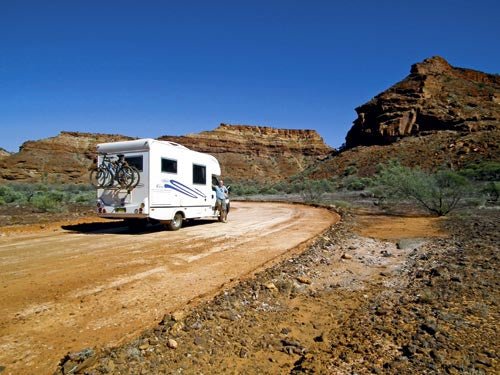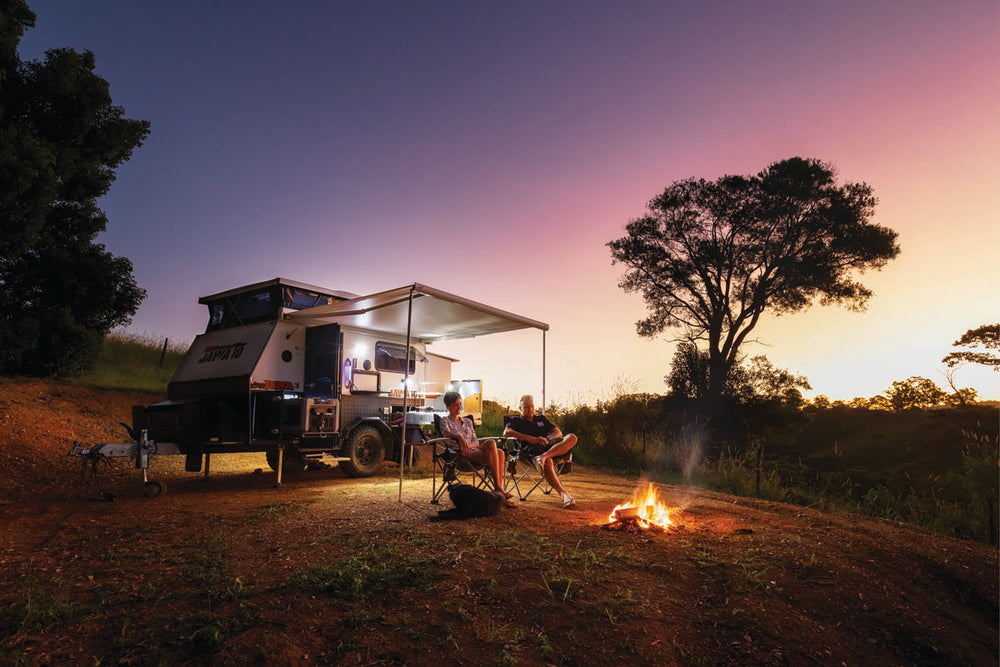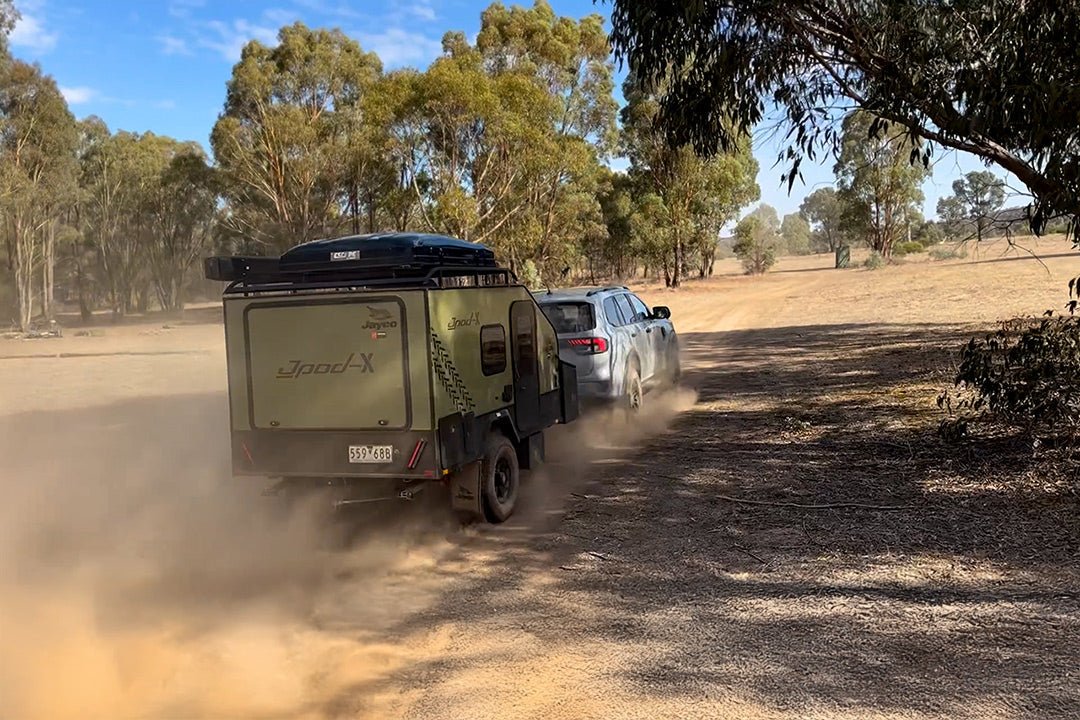DESTINATION: KENNEDY RANGE NATIONAL PARK, WESTERN AUSTRALIA

The noise outside our van at 2am sounded like a shopping trolley being dragged across the rubble car park we were staying in beside the lush green sports field at Gascoyne Junction in outback Western Australia.
The noise continued unabated and, because we were camping by ourselves, I thought I had better check what was going on. As I slowly, silently, and somewhat nervously opened the door, I was immediately hit with what felt like a massive burst of cold water from a huge fire hose. I thought it was a cruel joke. With a thumping heart, I reeled back inside, slamming the door – completely soaked. As the door clicked into place, I roared with laughter because I suddenly realised what had happened. We had parked on the edge of the football field and the sprinkler system was programmed to water the fields at 2am – saturating me in my short, thin, blue cotton pyjamas.
We had parked our motorhome in the tiny outback town as we were on our way from Carnarvon to Kennedy Range NP and then on to the world’s largest rock at Mt Augustus. We originally didn’t intend to go to Kennedy Range but, given we share our name with this remote wilderness area, we thought we should put it on the itinerary. We still had 60km to travel and we were too tired to continue. There was no local free camping at Gascoyne Junction, nor a recognised van park, so we stayed by the local sports oval after checking with Upper Gascoyne Council first. We later bumped into the friendly council chief executive, Dirk Sellinger, who gave us the great news that work was about to begin on a new caravan park – the $7.6 million Gascoyne Junction Roadhouse, Camping and Caravan Park. It is being incorporated within the town’s new tavern, 24-hour fuel stop and roadhouse. The previous pub was washed away in a massive flood in December 2010, which devastated
the town after the raging waters of Western Australia’s longest river – the Gascoyne – tore through its banks. It’s hoped the new pub and van park will be open to RVers by March 2013.
Gascoyne Junction is an ideal stopover for travellers as it is 177km from Carnarvon along an excellent and entirely-sealed bitumen road. But there is no room for complacency as, on our trip along the road, a car ran out of control and rolled over in the scrub. It was a frightening scene.
ON THE ROAD
Once you hit Gascoyne Junction, the road turns to dirt but it is very well-formed and graded regularly by the shire. Our Iveco-based motorhome powered over the 60km route with ease.
On this part of our trip from Gascoyne Junction to Kennedy Range, we didn’t see a single vehicle on the one-hour journey to this very rugged and popular destination.
Located 160km from the coast, the stunning Kennedy Range is found on the edge of the Gascoyne River Catchment. The range and its striking rocky gorges are protected by the Kennedy Range NP. During the warm winter months, when Kennedy Range is at its most popular, there are volunteer national park camp hosts to keep the dozen or so busy sites organised. These volunteers are a great resource as they are always armed with maps and general information about the various gorges and scenic spots. Their strong advice to us was to check out the Escarpment Trail and to ensure we didn’t miss sunrise from the specially-constructed viewing area near Honeycomb Gorge.
We set the van up in the quite spacious, but very dusty, campground, said hello to a few fellow travellers and then headed off for our first walk. We selected Temple Gorge as it is a short walk of just 2km return, which can be easily completed in about two hours. Temple Gorge is a rocky and, at times, steep walk with two offshoots, which allows you to choose either an easier one or, if you are feeling fit, you can do both. Take either offshoot and you will be rewarded with wonderful views up and into the red towering cliffs.
Earlier, at our campsite, we noticed a 4WD outback adventure tour vehicle full of very fit-looking middle aged bushwalkers who looked like they would be keen bird watchers. This observation turned out to be correct as we passed them on our way out of Temple Gorge and they chattered about the various birds and enthusiastically pointed out a native red-tailed lizard basking on a hot orange rock. Temple Gorge gets its name from the shape of the huge red and orange temple-shaped rock that sits atop the centre of the gorge.
If you are looking for a swim in the winter months at Kennedy Range, then you have come to the wrong place. There was barely a drop of water in any of the waterways. Come back in the summer and the waterways will be brimming with water roaring through the rocky gorges. But the downside is that it is extremely hot at that time of year.
We clambered back down the gorge to watch the sunset from our campsite and then prepared ourselves for an early morning trip to Honeycomb Gorge for the sunrise and back along the Escarpment Trail.
CRACK OF DAWN
Rather than wake the entire campsite by starting our vehicle at dawn, we rode our pushbikes along the 4km dirt road out to the sunrise viewing area at Honeycomb Gorge. It was a good way to clear the cobwebs as well. When we arrived at the viewing area, there were just a handful of people already there to witness the magnificent golden dawn striking the huge red rocks that towered above us. The rocks hit by the rays are very close, so there were some interesting poses by photographers who are literally bent on getting the best shots.
Once the show was over, we jumped back on our push bikes and rode around to the other side of Honeycomb Gorge to see the morning rays from another angle. This was another wonderful experience. Then it was back to the main camp for a complete lathering in sunscreen before heading off on the 3.4km return, sun-soaked journey up to the Escarpment Trail where we were told the view was exceptional. This walk is known as a Class 4 walk. It can be easily completed in three hours. But you will need to be steady of foot and prepared for some moderately steep sections. There are plenty of loose rocks and some dangerous cliffs, so stick to the main track.
Once you reach the top, the view is awesome. You can see for what seems like hundreds of kilometres in all directions. There is an excellent view over the campsite as well.
It is worth walking across the top of the escarpment until you see the chocolate coloured Drapers Gorge looming ahead of you. Walk along the rim of the trail and yell your lungs out because this area has the best echo we have ever heard.
Surprisingly, we had the entire flat-topped summit to ourselves. There was not another soul around. We took in the view and atmosphere then headed back down from the top. We met a few groups of people heading up as we went down and so we passed on our tip about the great echoes.
As we descended, we took our time as it can be a little precarious. It’s worth thinking about how long it would take for help to get to you and then transport you to hospital if you should stumble and break an ankle on a walk like this. At Karijini Gorge, in the north of WA, there is a huge poster that tells you if you hurt yourself in one of the gorges you will probably be there overnight before rescue services could get you out. So in these remote parts, be very cautious.
As we carefully descended the rugged escarpment, we marvelled at the spectacular beauty of this remote area as we took in the glorious views. This ancient eroded plateau has so much to offer. Interestingly, Kennedy Range was thought to have been part of a shallow ocean basin off the edge of Australia. Today, marine fossils can be found in the range’s sandstone strata, lending credibility to the theory.
LOCAL GEOGRAPHY
Kennedy Range forms a massive mesa, 75km long and 25km wide. If you enjoy plantlife, you will no doubt be interested to learn that there are 400 plant species in the area, including 80 species of wildflowers. August and September are the best time times to see them. If you hear some strange noises at night, then just relax, as there are 20 mammal species, including bats, 33 reptile species and 100 bird varieties.
Historically, Kennedy Range seems to have been part of the traditional lands of the Maia and Malgaru Aboriginal people. In 1858, explorer Francis Gregory named the ranges after the governor of Western Australia, Arthur Edward Kennedy. Later, the area was taken up and used for sheep grazing but a forward-thinking WA government acquired the lease, which later was dedicated as the Kennedy Range National Park.
Before heading to Kennedy Range, be sure to top up with fuel at Gascoyne Junction as there is no fuel and water at Kennedy Range. But there is fuel at Mt Augustus if you are heading that way.
Back at the campground, it was good to see that those travellers who were perhaps a little less mobile or who were just wanting a rest were sitting in chairs gazing skywards at the soaring red cliffs. You don’t have to be a walker to enjoy the area because you and your RV are located right in the middle of the action. So relax, put your feet up, and take in some of the best outback views in WA.
As for us, we packed up and headed towards the destination I had set my eyes on since we left Sydney two months earlier – Mt Augustus – home to the largest rock in the world. It is another 260km but worth every kilometre of sometimes-corrugated but always dusty red road.
On our trip out of Kennedy Range to Mt Augustus we did not see another vehicle for the entire day except for a caravan owned by Christine and Lee Potts, which was parked on the side of the road. We pulled over and had a chat and discovered they were the support vehicle for Christine’s son, 38-year-old marathon runner Phil Riley who was running, yes running, between Mt Augustus and Kennedy Range. He was undertaking the 260km run over five days along this hot, dusty trail. He is a very fit man, having taken part in the tragic 2011 Kimberley ultra-marathon in which two women were critically injured in a bushfire. We photographed him with his dedicated support crew and then headed off on our own adventure – conquering the well-graded road into Mt Augustus and then the big climb atop the biggest rock in the world.
AUSTRALIA’S NEWEST VAN PARK
- Located just 60km from Kennedy Range and 300km from Mt Augustus, the Gascoyne Junction Roadhouse, Camping and Caravan Park (artist’s rendering below) is ideally located for the weary traveller keen to be comfortable in the outback.
- In mid-2012, work on Australia’s latest park had begun. It will have 12 powered van sites, restaurant, powered and unpowered camping sites, eight cabins, swimming pool, tavern, shop, hot showers, playground, flushing toilets and 24-hour fuel.
- The town was connected to wireless internet and the mobile phone network in 2012, and has full television coverage.
- The council-owned $7.6 million van park is expected to be open to the public by March 2013.
FAST FACTS
- There is 177km of sealed road all the way from Carnarvon to Gascoyne Junction along the Carnarvon Mullewa Road. From there, it is 60km of good-quality dirt road to Kennedy Range. Stay at Gascoyne Junction the night before completing the 60km trip.
- Kennedy Range was named in 1858 after WA governor Arthur Edward Kennedy.
- Trails in Kennedy Range, proclaimed a national park in 1993, are well marked.
- Take plenty of water.
- Roads suitable for 2WD.
- Flights and tours can be booked at Carnarvon and other local towns.
- Shire of Gascoyne: www.uppergascoyne.wa.gov.au, (08) 9943 0988.
- Tourism WA: www.westernaustralia.com
Originally published in Caravan World #510, January 2013.







